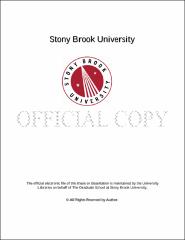| dc.identifier.uri | http://hdl.handle.net/11401/77268 | |
| dc.description.sponsorship | This work is sponsored by the Stony Brook University Graduate School in compliance with the requirements for completion of degree. | en_US |
| dc.format | Monograph | |
| dc.format.medium | Electronic Resource | en_US |
| dc.language.iso | en_US | |
| dc.publisher | The Graduate School, Stony Brook University: Stony Brook, NY. | |
| dc.type | Dissertation | |
| dcterms.abstract | Regulations mandate consistent procedures for information access, processing, and storage. In the United States alone, over 10,000 data management regulations exist in the financial, life sciences, health care and government sectors. A recurrent theme in data management regulations is the need for regulatory compliant storage to ensure data confidentiality, data integrity, audit trails maintenance, data retention, and guaranteed deletion. This thesis describes the design and implementation of several regulatory compliant relational databases and file systems. The systems increase efficiency and lower costs of regulatory compliance through the use of novel cryptographic and system security constructs. The first system described in this thesis is TrustedDB. TrustedDB is a relational database that ensures data confidentiality. TrustedDB enables SQL query execution over an encrypted database hosted with a remote, untrusted service provider. TrustedDB is the first DBMS with data confidentiality that does not limit query expressiveness. Moreover, the per query execution costs in TrustedDB are orders of magnitude lower than current cryptography-based mechanisms. To significantly lower query execution costs, TrustedDB leverages server-hosted, tamper-proof trusted hardware in critical query processing stages. The second system described in this thesis is CorrectDB. CorrectDB is a relational database that provides efficient, low-cost Query Authentication (QA). QA requires strict guarantees for both the correctness and completeness of the query results returned by potentially compromised providers. Similar to TrustedDB, CorrectDB leverages server-hosted trusted hardware. CorrectDB achieves economy and efficiency by minimizing server-side authentication data and by reducing the client-server communication overheads. The third system described in this thesis is ConcurDB. ConcurDB provides concurrent query authentication in a multi-client scenario wherein many clients simultaneously perform update operations. ConcurDB achieves high concurrency by decoupling transaction execution and verification -- permitting transactions to execute concurrently and performing verifications in parallel. The fourth system described in this thesis is the history independent file system (HIFS). HIFS guarantees secure data deletion by providing full history independence across both file system and disk layers of the storage stack. HIFS overcomes the challenge of simultaneously preserving history independence and data locality. Moreover, HIFS is customizable to suit several data locality scenarios, such as block-group locality and sequential file storage. This thesis also builds the theoretical foundations of history independence. The thesis explores the concepts of abstract data types, data structures, machine models, memory representations and history independence itself. The thesis then proposes $Delta$ history independence ($Delta$HI), a generic game-based framework that is malleable enough to define a broad spectrum of new history independence notions. To bridge the gap between theory and practice, the thesis outlines a general process for building history independent systems. HIFS itself is designed using the suggested process. Finally, this thesis describes Ficklebase. Ficklebase is a relational database that provides irrecoverable data erasure. In Ficklebase, once a tuple is deleted all side effects of the delete tuple are removed. Removal of all side effects of a deleted tuple achieves the same effect as if the deleted tuple was never inserted in the database. Ficklebase thus eliminates all traces of deleted data rendering data irrecoverable and also guaranteeing that the deletion itself is undetectable. | |
| dcterms.available | 2017-09-20T16:52:19Z | |
| dcterms.contributor | Zadok, Erez | en_US |
| dcterms.contributor | Sion, Radu | en_US |
| dcterms.contributor | Porter, Donald | en_US |
| dcterms.contributor | Gehrke, Johannes. | en_US |
| dcterms.creator | Bajaj, Sumeet Vijay | |
| dcterms.dateAccepted | 2017-09-20T16:52:19Z | |
| dcterms.dateSubmitted | 2017-09-20T16:52:19Z | |
| dcterms.description | Department of Computer Science. | en_US |
| dcterms.extent | 250 pg. | en_US |
| dcterms.format | Monograph | |
| dcterms.format | Application/PDF | en_US |
| dcterms.identifier | http://hdl.handle.net/11401/77268 | |
| dcterms.issued | 2014-12-01 | |
| dcterms.language | en_US | |
| dcterms.provenance | Made available in DSpace on 2017-09-20T16:52:19Z (GMT). No. of bitstreams: 1
Bajaj_grad.sunysb_0771E_12082.pdf: 7603031 bytes, checksum: 894f9313e24a5cdab8725cf663a57545 (MD5)
Previous issue date: 1 | en |
| dcterms.publisher | The Graduate School, Stony Brook University: Stony Brook, NY. | |
| dcterms.subject | CorrectDB, History Independence, Regulatory Compliance, Security, TrustedDB, Trusted Hardware | |
| dcterms.subject | Computer science | |
| dcterms.title | Achieving Regulatory Compliance in Data Management | |
| dcterms.type | Dissertation | |

